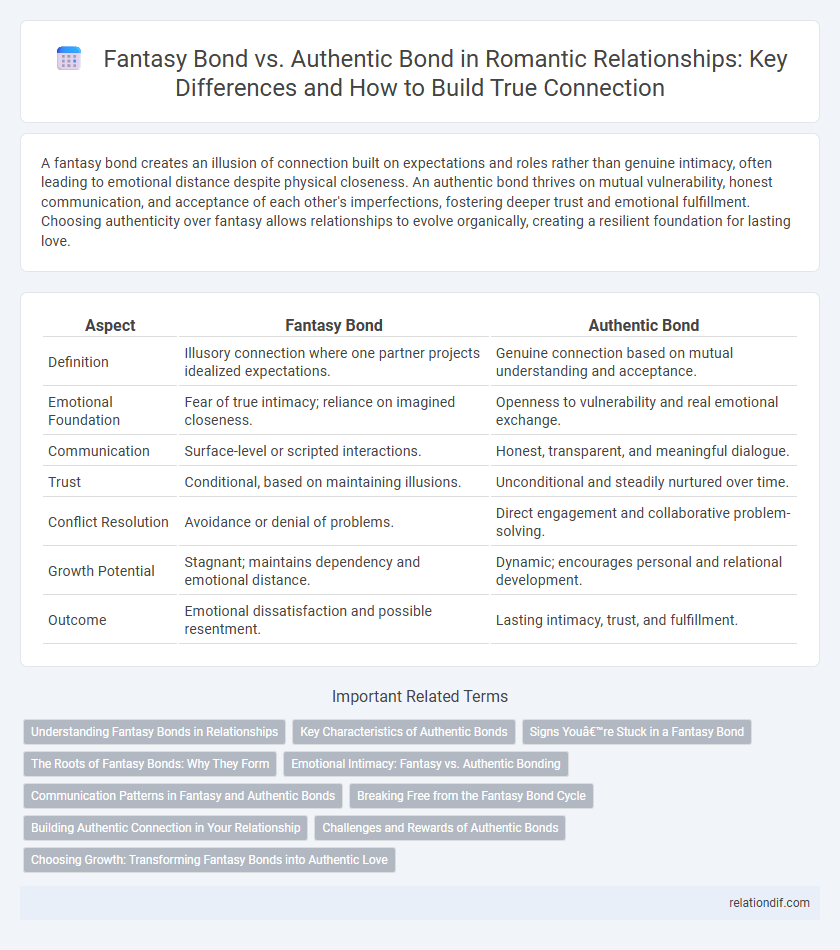A fantasy bond creates an illusion of connection built on expectations and roles rather than genuine intimacy, often leading to emotional distance despite physical closeness. An authentic bond thrives on mutual vulnerability, honest communication, and acceptance of each other's imperfections, fostering deeper trust and emotional fulfillment. Choosing authenticity over fantasy allows relationships to evolve organically, creating a resilient foundation for lasting love.
Table of Comparison
| Aspect | Fantasy Bond | Authentic Bond |
|---|---|---|
| Definition | Illusory connection where one partner projects idealized expectations. | Genuine connection based on mutual understanding and acceptance. |
| Emotional Foundation | Fear of true intimacy; reliance on imagined closeness. | Openness to vulnerability and real emotional exchange. |
| Communication | Surface-level or scripted interactions. | Honest, transparent, and meaningful dialogue. |
| Trust | Conditional, based on maintaining illusions. | Unconditional and steadily nurtured over time. |
| Conflict Resolution | Avoidance or denial of problems. | Direct engagement and collaborative problem-solving. |
| Growth Potential | Stagnant; maintains dependency and emotional distance. | Dynamic; encourages personal and relational development. |
| Outcome | Emotional dissatisfaction and possible resentment. | Lasting intimacy, trust, and fulfillment. |
Understanding Fantasy Bonds in Relationships
Fantasy bonds in relationships create an illusion of connection based on dependency and imagined safety rather than genuine emotional intimacy. This psychological construct often leads to controlling behaviors and unmet emotional needs, hindering true vulnerability and trust between partners. Recognizing and dismantling fantasy bonds allows couples to develop authentic bonds grounded in honest communication and mutual respect.
Key Characteristics of Authentic Bonds
Authentic bonds in romance are characterized by mutual trust, open communication, and emotional vulnerability, allowing partners to connect deeply and genuinely. These bonds emphasize personal growth and individuality within the relationship, fostering a sense of security without dependency. Emotional authenticity, respect for boundaries, and reciprocal support are essential elements distinguishing authentic bonds from fantasy bonds.
Signs You’re Stuck in a Fantasy Bond
Signs you're stuck in a fantasy bond include idealizing your partner while ignoring red flags, feeling emotionally distant despite physical closeness, and prioritizing appearances over genuine connection. You may find yourself suppressing true feelings to maintain an illusion of harmony, leading to unresolved conflicts and growing resentment. Recognizing these signs is crucial to shifting from a fantasy bond to an authentic bond built on honesty, vulnerability, and mutual respect.
The Roots of Fantasy Bonds: Why They Form
Fantasy bonds form from deep-seated fears of vulnerability and emotional intimacy, driving individuals to create illusions of connection rather than genuine closeness. These bonds often stem from unmet childhood needs or past relationship traumas, leading to dependency on scripted roles instead of authentic self-expression. Recognizing these roots is crucial for transforming fantasy bonds into authentic bonds based on mutual trust and emotional transparency.
Emotional Intimacy: Fantasy vs. Authentic Bonding
Fantasy bonds in romantic relationships create an illusion of closeness based on idealized expectations, often masking true emotional intimacy. Authentic bonds emerge from genuine vulnerability and transparent communication, fostering deep emotional connection and trust. Prioritizing authentic bonding enhances relationship satisfaction by allowing partners to experience real emotional closeness beyond surface-level fantasy.
Communication Patterns in Fantasy and Authentic Bonds
Fantasy bonds rely on idealized communication patterns that mask true feelings and create illusions of connection, often leading to misunderstandings and emotional distance. Authentic bonds emphasize open, honest dialogue where partners express vulnerabilities and actively listen, fostering trust and deeper intimacy. Effective communication in authentic bonds facilitates emotional transparency and conflict resolution, contrasting sharply with the superficial exchanges typical of fantasy bonds.
Breaking Free from the Fantasy Bond Cycle
Breaking free from the fantasy bond cycle requires recognizing the difference between an idealized connection and an authentic bond rooted in mutual vulnerability and truth. A fantasy bond often masks emotional distance through scripted roles and expectations, while an authentic bond embraces genuine communication and individuality. Cultivating emotional honesty and self-awareness dismantles illusions, fostering intimacy based on reality rather than escapism.
Building Authentic Connection in Your Relationship
Building an authentic bond in a romantic relationship involves fostering genuine emotional intimacy through open communication, vulnerability, and mutual respect, contrasting the fantasy bond's reliance on idealized expectations and avoidance of conflict. Prioritizing authenticity allows partners to connect deeply beyond surface-level roles, promoting trust and long-term commitment grounded in reality rather than illusion. Emphasizing presence and acceptance in interactions cultivates a resilient partnership that can navigate challenges with empathy and understanding.
Challenges and Rewards of Authentic Bonds
Authentic bonds in romance demand vulnerability and open communication, challenging partners to confront insecurities and fears of rejection. Overcoming these obstacles leads to deeper emotional intimacy and trust, fostering a resilient connection. The rewards include genuine understanding, mutual growth, and a fulfilling partnership based on transparency rather than illusion.
Choosing Growth: Transforming Fantasy Bonds into Authentic Love
Fantasy bonds create a connection based on illusions and unmet emotional needs, hindering true intimacy in romantic relationships. Choosing growth involves recognizing these patterns and fostering vulnerability, trust, and genuine communication to cultivate authentic bonds. Transforming fantasy bonds into authentic love empowers partners to experience deep emotional connection and lasting fulfillment.
Fantasy Bond vs Authentic Bond Infographic

 relationdif.com
relationdif.com